GALLUP NEWS SERVICE
PRINCETON, NJ -- Final CNN/USA Today/║┌┴¤═° showdown state polls underscore how close the presidential election between President George W. Bush and Democratic candidate John Kerry is likely to be. The polls show mixed results in six of the most hotly contested states -- with Kerry leading in one state (Minnesota), Bush leading in one (Wisconsin), and the results of four others (Iowa, Pennsylvania, Ohio, and Florida) within the polls' margins of error. The polls were mostly conducted between Wednesday and Saturday, with polling in Ohio and Pennsylvania continuing into Sunday.
|
|
Likely Voters |
|||||
|
2004 Oct 27-31 |
Fla. ^ |
Iowa |
Minn. |
Ohio |
Penn. |
Wis. |
|
|
% |
% |
% |
% |
% |
% |
|
John Kerry and John Edwards (D) |
50 |
46 |
52 |
50 |
46 |
44 |
|
George W. Bush and Dick Cheney (R) |
47 |
48 |
44 |
46 |
50 |
52 |
|
Ralph Nader and Peter Camejo (I) |
* |
2 |
1 |
-- |
-- |
1 |
|
Other |
* |
* |
* |
* |
* |
* |
|
No opinion |
3 |
4 |
3 |
4 |
4 |
3 |
|
|
||||||
In a close election, turnout is usually a decisive factor. ║┌┴¤═° polling supports many political observers' predictions that turnout will be very high in these states -- in all six, roughly 9 in 10 residents say they have given quite a lot of thought to the election. In Florida, 30% of registered voters say they have already voted.
Also, it is generally believed that in elections involving incumbent candidates, undecided voters will disproportionately wind up voting for the challenger. That is based on the assumption that voters who cannot bring themselves to express support for the incumbent, despite their familiarity, are more likely to vote against the incumbent on Election Day. If that holds this year, Kerry could emerge victorious in all of the previously mentioned states except Wisconsin, assuming there are no last-minute shifts in the electorate's preferences in the final two days of the campaign. Of course, the 2004 election is unlike any other before it, so it is far from certain that prior historical patterns will hold -- particularly given both parties' massive get-out-the-vote efforts in these key swing states.
Florida
The Oct. 28-30 CNN/USA Today/║┌┴¤═° Florida pre-election poll shows that among likely voters, Kerry has a slight edge over Bush, 50% to 47%. Ralph Nader, believed by some to have cost Al Gore Florida's electoral votes in 2000, receives less than 1% of the vote, and so is less likely to be a factor this year. Still, Kerry's lead is within the poll's margin of error, and in a close race, any votes for Nader that might otherwise have gone for Kerry could be decisive. Kerry has a slightly larger lead (but still not statistically significant) among all registered voters, 49% to 45%.
That represents a significant improvement for Kerry in the past week, who trailed Bush by eight points among likely voters in Florida in the Oct. 21-24 CNN/USA Today/║┌┴¤═° poll. This also represents the first time Kerry has had a numerical advantage over Bush in the six Florida polls conducted by ║┌┴¤═° during this campaign.
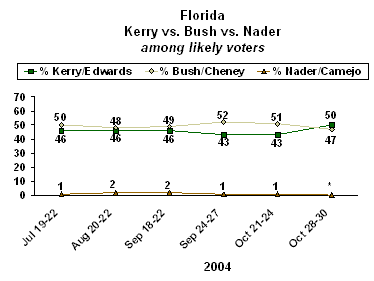
║┌┴¤═° continued polling in Florida on Sunday evening to detect any late movement toward either candidate in this crucial state, which presents the biggest prize of electoral votes (27) that is still up for grabs. Bush was awarded the state's electoral votes in 2000 after the Supreme Court ruled against the Gore campaign's attempt to get a recount of the votes. The Florida secretary of state certified Bush as the winner by 537 votes.
The state's race for U.S. Senate is also too close to call. The poll has Democratic candidate Betty Castor at 48% and Republican candidate Mel Martinez at 46%, with 6% undecided or supporting minor-party candidates.
Pennsylvania
The Republican Party has targeted Pennsylvania, and its 21 electoral votes, as one of the "blue" states that could become a "red" state this year. Bush has visited Pennsylvania more times than any other state. Gore won by four percentage points in 2000, and the latest poll suggests another competitive race -- Bush has a 50% to 46% edge among likely voters in Pennsylvania, within the poll's margin of error.
Bush's current edge among likely voters may result from the fact that Pennsylvania is one of two states among the six where the economy is not the most important issue for voters. In Pennsylvania, 31% of voters say terrorism is the most important issue to their votes and 28% say the economy, when given a choice of those issues plus Iraq and healthcare. Terrorism is Bush's signature political issue.
Nevertheless, the presidential race in the Keystone State has been close throughout the campaign. Bush's current four-point edge is the largest for either candidate this year, and neither candidate has held a statistically significant lead over the other in four previous ║┌┴¤═° Polls of Pennsylvania.
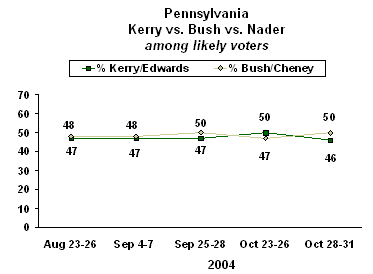
Kerry has a slight 49% to 47% edge among registered voters in Pennsylvania, suggesting that high turnout could work in his favor on Election Day.
Ohio
Just as the Republican Party has targeted Pennsylvania as a state to pick up in 2004, the Democrats have targeted Ohio and its 20 electoral votes. The Oct. 28-31 CNN/USA Today/║┌┴¤═° final pre-election poll of Ohio shows Kerry at 50% and Bush at 46% among likely voters, a lead that is within the poll's margin of error. Like Pennsylvania, the state has remained tightly contested throughout the campaign. Bush enjoyed a significant lead in the state right after the Republican National Convention in late August/early September.
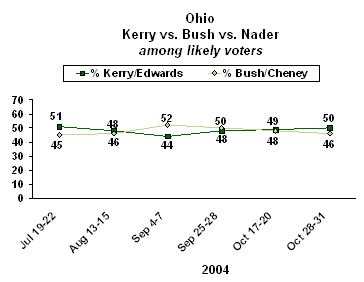
Ohio's sluggish economy is one reason why Kerry has been competitive in a state that usually holds the key to Republican victory. Thirty-three percent of Ohio likely voters say the economy is the most important issue to their votes, putting it ahead of terrorism (27%), Iraq (23%) and healthcare (14%).
Wisconsin
Beyond the big three states previously discussed, Wisconsin has been a frequent campaign stop on the candidates' circuits. Gore won the state by less than two-tenths of a percentage point in 2000. Wisconsin appears to offer the Bush campaign a good chance to pick up a state that he did not win in 2000. Bush has had a numerical if not a statistical advantage in all five Wisconsin polls, and his current 52% to 44% advantage among likely voters represents a statistically significant lead.
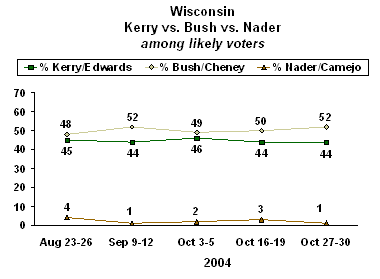
Typically, Bush has held an edge among registered voters in the Badger State; making it unlikely that high turnout alone could tip the scales in Kerry's favor. In the latest poll, registered Wisconsin voters support Bush by a 49% to 46% margin.
Minnesota
Wisconsin and its geographical neighbor Minnesota have some political similarities. Both states will award 10 electoral votes to the winner, and both have supported Democratic presidential candidates in the last four elections, but are now very competitive. The Oct. 28-30 poll of likely Minnesota voters shows Kerry is likely to keep Minnesota in Democratic hands (Gore won the state in 2000), as he leads Bush by a 52% to 44% margin, with Nader at 1%.
Among registered voters, Kerry leads 51% to 43%. Both Kerry's leads are outside the poll's margin of error. However, the day-by-day figures suggested a much closer race on Saturday than on the prior two days, so the final numbers could be closer than the projected eight-point margin of victory.
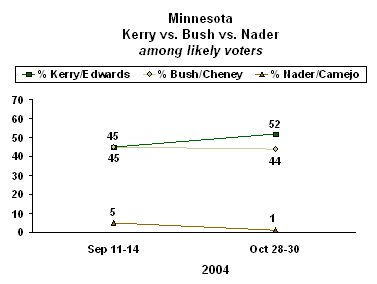
Iowa
Like Wisconsin, Iowa voted for Gore by the slimmest of margins in 2000, less than four-tenths of a percentage point. Although the winning candidate in Iowa receives just seven electoral votes, they are no less crucial than any other in a race that could very well provide one of the smallest Electoral College victories on record. The Oct. 27-30 poll shows Bush at 48% support and Kerry at 46% among likely Iowa voters, the closest result among the six state polls. Nader gets 2% in his best performance among these six states. Among registered voters, Bush has an even slimmer 47% to 46% advantage.
In the prior two Iowa polls, Bush had a slight advantage, while Kerry had an edge in the initial Iowa poll in August.
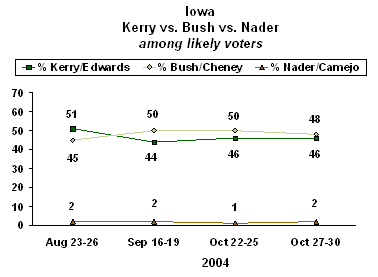
The Electoral College Outlook
These polling results do not provide a clear indication of the likely winner on Election Day, though the polls confirm that the presidential race will be close. Florida, Ohio, and Pennsylvania will probably have the greatest impact on the race. If either candidate wins all three, he is virtually assured of winning the presidency. The candidate who can win two of three will have a significant advantage, although not necessarily a guarantee of ultimate victory.
For example, if Kerry loses two of the three big states, he would have to overcome Bush's edge in Wisconsin while also winning Iowa, New Mexico, and taking New Hampshire (or pull a big upset in a state that is currently leaning Republican, such as Missouri or Colorado). On the other hand, if Bush were to lose Ohio and Florida, he could still win the Electoral College vote if he wins Pennsylvania, Wisconsin, Iowa, and New Mexico.
While there are many other possibilities, it seems clear that in addition to the three key states of Ohio, Florida, and Pennsylvania, the smaller states of Wisconsin, Minnesota, and Iowa -- and possibly New Mexico and New Hampshire as well -- could also play a crucial role. Bush almost has to win Wisconsin or Minnesota plus Iowa if he does not win two of the three big states.
The table lists the electoral votes available by state, and which are likely to go Republican and Democratic. The winning candidate will need to win 270 out of 538. Some of the large group of tossup states are leaning in Kerry's direction, according to available polling data from ║┌┴¤═° and other organizations, and some are leaning in Bush's direction. Given the closeness of the race, even the slightest of shifts in voter preference in the last two days of the campaign could have a dramatic effect on the outcome.
It is also not beyond the realm of possibility that each candidate could get 269 electoral votes. One plausible scenario resulting in a tie would have Bush winning Florida, Wisconsin, and New Mexico while Kerry wins Minnesota, Iowa, Pennsylvania, Ohio, and New Hampshire (with the other states going in the direction they are currently leaning). In that case, the U.S. House of Representatives would make the final decision, with Bush likely emerging victorious in that case since Republicans have a majority of congressional delegations.
Distribution of Electoral Votes, 2004 Election
|
Likely Kerry |
Tossup |
Likely Bush |
|
|
|
|
|
District of Columbia (3) |
Leaning Kerry |
Tennessee (11) |
|
Rhode Island (4) |
New Jersey (15) |
Louisiana (9) |
|
Massachusetts (12) |
Hawaii (4) |
Georgia (15) |
|
New York (31) |
Washington (11) |
Indiana (11) |
|
Connecticut (7) |
Michigan (17) |
South Carolina (8) |
|
Maryland (10) |
Maine (4) |
Kentucky (8) |
|
Delaware (3) |
Minnesota (10) |
Alabama (9) |
|
Illinois (21) |
Oregon (7) |
Mississippi (6) |
|
California (55) |
New Hampshire (4) |
Kansas (6) |
|
Vermont (3) |
|
Oklahoma (7) |
|
|
Unclear |
Texas (34) |
|
|
Ohio (20) |
South Dakota (3) |
|
|
Florida (27) |
Montana (3) |
|
|
Iowa (7) |
North Dakota (3) |
|
|
Pennsylvania (21) |
Nebraska (5) |
|
|
New Mexico (5) |
Alaska (3) |
|
|
|
Idaho (4) |
|
|
Leaning Bush |
Wyoming (3) |
|
|
Wisconsin (10) |
Utah (5) |
|
|
Nevada (5) |
|
|
|
Missouri (11) |
|
|
|
Arkansas (6) |
|
|
|
West Virginia (5) |
|
|
|
Colorado (9) |
|
|
|
Virginia (13) |
|
|
|
North Carolina (15) |
|
|
|
Arizona (10) |
|
|
Total: 149 |
Total: 236 (72 leaning Kerry; 84 leaning Bush; 80 unclear) |
Total: 153 |
Survey Methods
FLORIDA
Results are based on telephone interviews with 1,300 registered voters in Florida, aged 18 and older, conducted Oct. 28-30, 2004. For results based on this sample, one can say with 95% confidence that the margin of sampling error is ±3 percentage points.
Results for likely voters in Florida are based on the subsample of 1,138 survey respondents deemed most likely to vote in the November 2004 presidential election, according to a series of questions measuring current voting intentions and past voting behavior. For results based on the total sample of likely voters, one can say with 95% confidence that the margin of sampling error is ±3 percentage points. Based on past voting history in Florida and the current level of interest in the election, turnout is assumed to be 60% of the voting age population.
Approximately 3% of all interviews in Florida were conducted in Spanish.
Presidential Trial Heat Preference: Bush vs. Kerry vs. Nader
4. (Asked of those who have not already voted) Now, suppose that the presidential election were being held today, and it included John Kerry and John Edwards as the Democratic candidates, George W. Bush and Dick Cheney as the Republican candidates, and Ralph Nader and Peter Camejo as independent candidates. Would you vote for – [ROTATED: Kerry and Edwards, the Democrats, Bush and Cheney, the Republicans, (or) Nader and Camejo, the independent candidates]?
4A. As of today, do you lean more toward – [ROTATED: Kerry and Edwards, the Democrats, Bush and Cheney, the Republicans (or) Nader and Camejo, the independents]?
4-1. (Asked of those who already voted) Who did you vote for in the presidential election? [OPEN-ENDED]
|
|
|
Kerry/ |
Bush/ |
Nader/ |
Other |
No |
|
|
|
|
% |
% |
% |
% |
% |
|
|
|
Likely voters |
|
|
|
|
|
|
|
|
2004 Oct 28-30 |
49 |
46 |
* |
* |
5 |
|
|
|
Final Allocated Estimate ^ |
50 |
47 |
* |
* |
3 |
|
|
|
|
|
|
|
|
|
|
|
|
2004 Oct 21-24 |
43 |
51 |
1 |
* |
5 |
|
|
|
2004 Sep 24-27 |
43 |
52 |
1 |
-- |
4 |
|
|
|
2004 Sep 18-22 |
46 |
49 |
2 |
* |
3 |
|
|
|
2004 Aug 20-22 |
46 |
48 |
2 |
* |
4 |
|
|
|
2004 Jul 19-22 |
46 |
50 |
1 |
* |
3 |
|
|
|
|
|
|
|
|
|
|
|
|
Registered voters |
|
|
|
|
|
|
|
|
2004 Oct 28-30 |
49 |
45 |
1 |
* |
5 |
|
|
|
2004 Oct 21-24 |
42 |
51 |
1 |
* |
6 |
|
|
|
2004 Sep 24-27 |
44 |
49 |
2 |
-- |
5 |
|
|
|
2004 Sep 18-22 |
45 |
47 |
2 |
* |
6 |
|
|
|
2004 Aug 20-22 |
45 |
45 |
3 |
* |
7 |
|
|
|
2004 Jul 19-22 |
44 |
49 |
2 |
* |
5 |
|
|
|
|
|
|
|
|
|
|
|
^The responses of those in Florida who already voted, but who refuse to say who they voted for, are allocated proportionately to the share of the candidates' votes among the entire group of early voters (54% Kerry, 46% Bush). |
|
||||||
Senate Trial Heat Preference: Castor vs. Martinez
5. (Asked of those who have not already voted) Next, if the elections for Senator were being held today, which candidate would you vote for in your state – [ROTATED: Betty Castor, the Democrat (or) Mel Martinez, the Republican]?
5A. As of today, do you lean more toward – [ROTATED: Betty Castor, the Democrat (or) Mel Martinez, the Republican]?
5-1. (Asked of those who already voted) Next, who did you vote for in the election for U.S. Senate – [ROTATED: Betty Castor, the Democrat, Mel Martinez, the Republican], or someone else?
|
|
|
|
Other |
No |
|
|
% |
% |
% |
% |
|
Likely voters |
|
|
|
|
|
2004 Oct 28-30 |
48 |
46 |
1 |
5 |
|
2004 Sep 18-22 |
51 |
45 |
-- |
4 |
|
|
|
|
|
|
|
Registered voters |
|
|
|
|
|
2004 Oct 28-30 |
48 |
45 |
* |
7 |
|
2004 Sep 18-22 |
49 |
43 |
-- |
8 |
6. (Asked of those who have not already voted) If you had to choose, which of the following issues will be most important to your vote for president this year -- [ROTATED: the economy, terrorism, the situation in Iraq, (or) healthcare]?
6-1. (Asked of those who already voted) If you had to choose, which of the following issues was most important to your vote for president this year -- [ROTATED: the economy, terrorism, the situation in Iraq, (or) healthcare]?
|
|
|
Economy |
Terrorism |
Iraq |
Healthcare |
No opinion |
|
|
|
|
% |
% |
% |
% |
% |
|
|
|
Likely voters |
|
|
|
|
|
|
|
|
2004 Oct 28-30 |
27 |
30 |
26 |
14 |
3 |
|
|
|
2004 Jul 19-22 ^ |
31 |
29 |
19 |
20 |
1 |
|
|
|
|
|
|
|
|
|
|
|
|
Registered boters |
|
|
|
|
|
|
|
|
2004 Oct 28-30 |
29 |
28 |
23 |
17 |
3 |
|
|
|
2004 Jul 19-22 ^ |
31 |
28 |
19 |
20 |
2 |
|
|
|
|
|
|
|
|
|
|
|
^Re-calculated figures, removing volunteered "all" and "none" responses. |
|
||||||
Finally,
7. How confident are you that, in Florida, the votes for president will be accurately cast and counted in this year's election -- very confident, somewhat confident, not too confident, or not at all confident?
|
|
Very confident |
Somewhat confident |
Not too |
Not at all confident |
No |
|
|
% |
% |
% |
% |
% |
|
Likely voters |
|
|
|
|
|
|
2004 Oct 28-30 |
34 |
38 |
16 |
11 |
1 |
|
2004 Jul 19-22 |
45 |
32 |
15 |
7 |
1 |
|
|
|
|
|
|
|
|
Registered voters |
|
|
|
|
|
|
2004 Oct 28-30 |
33 |
37 |
18 |
11 |
1 |
|
2004 Jul 19-22 |
41 |
32 |
18 |
7 |
2 |
IOWA
Results are based on telephone interviews with 1,329 registered voters in Iowa, aged 18 and older, conducted Oct. 27-30, 2004. For results based on this sample, one can say with 95% confidence that the maximum margin of sampling error is ±3 percentage points.
Results for likely voters in Iowa are based on the subsample of 1,119 survey respondents deemed most likely to vote in the November 2004 presidential election, according to a series of questions measuring current voting intentions and past voting behavior. For results based on the total sample of likely voters, one can say with 95% confidence that the maximum margin of sampling error is ±3 percentage points. Based on past voting history in Iowa and the current level of interest in the election, turnout is assumed to be 65% of the voting age population.
Presidential Trial Heat Preference: Bush vs. Kerry vs. Nader
4. Now, suppose that the presidential election were being held today, and it included John Kerry and John Edwards as the Democratic candidates, George W. Bush and Dick Cheney as the Republican candidates, and Ralph Nader and Peter Camejo as independent candidates. Would you vote for – [ROTATED: Kerry and Edwards, the Democrats, Bush and Cheney, the Republicans, (or) Nader and Camejo, the independent candidates]?
4A. As of today, do you lean more toward – [ROTATED: Kerry and Edwards, the Democrats, Bush and Cheney, the Republicans (or) Nader and Camejo, the independents]?
|
|
Kerry/ |
Bush/ |
Nader/ |
Other |
No opinion |
|
|
% |
% |
% |
% |
% |
|
Likely voters |
|
|
|
|
|
|
2004 Oct 27-30 |
46 |
48 |
2 |
* |
4 |
|
|
|
|
|
|
|
|
2004 Oct 22-25 |
46 |
50 |
1 |
-- |
3 |
|
2004 Sep 16-19 |
44 |
50 |
2 |
* |
4 |
|
2004 Aug 23-26 |
51 |
45 |
2 |
* |
2 |
|
|
|
|
|
|
|
|
Registered voters |
|
|
|
|
|
|
2004 Oct 27-30 |
46 |
47 |
2 |
* |
5 |
|
2004 Oct 22-25 |
48 |
47 |
1 |
-- |
4 |
|
2004 Sep 16-19 |
43 |
48 |
3 |
1 |
5 |
|
2004 Aug 23-26 |
50 |
44 |
2 |
* |
4 |
Next,
5. If you had to choose, which of the following issues will be most important to your vote for president this year -- [ROTATED: the economy, terrorism, the situation in Iraq, (or) healthcare]?
|
|
Economy |
Terrorism |
Iraq |
Healthcare |
No opinion |
|
|
|
|
|
|
|
|
Likely voters |
|
|
|
|
|
|
2004 Oct 27-30 |
32% |
22 |
27 |
16 |
3 |
|
|
|
|
|
|
|
|
Registered voters |
|
|
|
|
|
|
2004 Oct 27-30 |
32% |
22 |
26 |
17 |
3 |
MINNESOTA
Results are based on telephone interviews with 1,271 registered voters in Minnesota, aged 18 and older, conducted Oct. 28-30, 2004. For results based on this sample, one can say with 95% confidence that the margin of sampling error is ±3 percentage points.
Results for likely voters in Minnesota are based on the subsample of 1,078 survey respondents deemed most likely to vote in the November 2004 presidential election, according to a series of questions measuring current voting intentions and past voting behavior. For results based on the total sample of likely voters, one can say with 95% confidence that the margin of sampling error is ±3 percentage points. Based on past voting history in Minnesota, turnout is assumed to be 70% of the voting age population.
4. Now, suppose that the presidential election were being held today, and it included John Kerry and John Edwards as the Democratic candidates, George W. Bush and Dick Cheney as the Republican candidates, and Ralph Nader and Peter Camejo as independent candidates. Would you vote for – [ROTATED: Kerry and Edwards, the Democrats, Bush and Cheney, the Republicans, (or) Nader and Camejo, the independent candidates]?
4A. As of today, do you lean more toward – [ROTATED: Kerry and Edwards, the Democrats, Bush and Cheney, the Republicans (or) Nader and Camejo, the independents]?
|
|
Kerry/ |
Bush/ |
Nader/ |
Other |
No |
|
|
% |
% |
% |
% |
% |
|
Likely voters |
|
|
|
|
|
|
2004 Oct 28-30 |
52 |
44 |
1 |
* |
3 |
|
|
|
|
|
|
|
|
2004 Sep 11-14 |
45 |
45 |
5 |
* |
5 |
|
|
|
|
|
|
|
|
Registered voters |
|
|
|
|
|
|
2004 Oct 28-30 |
51 |
43 |
2 |
* |
4 |
|
2004 Sep 11-14 |
44 |
44 |
6 |
* |
6 |
Next,
5. If you had to choose, which of the following issues will be most important to your vote for president this year -- [ROTATED: the economy, terrorism, the situation in Iraq, (or) healthcare]?
|
|
Economy |
Terrorism |
Iraq |
Healthcare |
No opinion |
|
|
|
|
|
|
|
|
Likely voters |
|
|
|
|
|
|
2004 Oct 28-30 |
32% |
24 |
26 |
15 |
3 |
|
|
|
|
|
|
|
|
Registered voters |
|
|
|
|
|
|
2004 Oct 28-30 |
33% |
23 |
25 |
16 |
3 |
OHIO
Results are based on telephone interviews with 1,314 registered voters in Ohio, aged 18 and older, conducted Oct. 28-31, 2004. For results based on this sample, one can say with 95% confidence that the margin of sampling error is ±3 percentage points.
Results for likely voters in Ohio are based on the subsample of 1,111 survey respondents deemed most likely to vote in the November 2004 presidential election, according to a series of questions measuring current voting intentions and past voting behavior. For results based on the total sample of likely voters, one can say with 95% confidence that the margin of sampling error is ±3 percentage points. Based on past voting history in Ohio, turnout is assumed to be 65% of the voting age population.
Presidential Trial Heat Preference: Bush vs. Kerry
2. Now, suppose that the presidential election were being held today, and it included John Kerry and John Edwards as the Democratic candidates and George W. Bush and Dick Cheney as the Republican candidates. Would you vote for – [ROTATED: John Kerry and John Edwards, the Democrats (or) George W. Bush and Dick Cheney, the Republicans]?
2A. As of today, do you lean more toward – [ROTATED: Kerry and Edwards, the Democrats (or) Bush and Cheney, the Republicans]?
|
|
Kerry/ |
Bush/ |
Other |
No |
|
|
|
% |
% |
% |
% |
|
|
Likely voters |
|
|
|
|
|
|
2004 Oct 28-31 |
50 |
46 |
* |
4 |
|
|
|
|
|
|
|
|
|
2004 Oct 17-20 ^ |
49 |
48 |
* |
3 |
|
|
2004 Sep 25-28 ^ |
48 |
50 |
* |
2 |
|
|
2004 Sep 4-7 |
44 |
52 |
* |
4 |
|
|
2004 Aug 13-15 |
48 |
46 |
* |
6 |
|
|
2004 Jul 19-22 |
51 |
45 |
-- |
4 |
|
|
|
|
|
|
|
|
|
Registered voters |
|
|
|
|
|
|
2004 Oct 28-31 |
51 |
44 |
* |
5 |
|
|
2004 Oct 17-20 ^ |
50 |
45 |
* |
5 |
|
|
2004 Sep 25-28 ^ |
50 |
46 |
* |
4 |
|
|
2004 Sep 4-7 |
47 |
48 |
* |
5 |
|
|
2004 Aug 13-15 |
52 |
42 |
* |
6 |
|
|
2004 Jul 19-22 |
49 |
44 |
-- |
7 |
|
|
|
|
|
|
|
|
|
^Re-calculated Bush-Kerry trial heat: Respondents initially asked for preference between Bush, Kerry, and Ralph Nader; Nader supporters then asked for preference between Bush and Kerry if Nader not on ballot. |
|
||||
Next,
5. If you had to choose, which of the following issues will be most important to your vote for president this year -- [ROTATED: the economy, terrorism, the situation in Iraq, (or) health care]?
|
|
Economy |
Terrorism |
Iraq |
Healthcare |
No opinion |
|
|
|
% |
% |
% |
% |
% |
|
|
Likely voters |
|
|
|
|
|
|
|
2004 Oct 28-31 |
33 |
27 |
23 |
14 |
4 |
|
|
2004 Sep 4-7 |
39 |
28 |
13 |
17 |
3 |
|
|
2004 Jul 19-21 ^ |
33 |
23 |
22 |
22 |
* |
|
|
|
|
|
|
|
|
|
|
Registered voters |
|
|
|
|
|
|
|
2004 Oct 28-31 |
35 |
25 |
20 |
15 |
5 |
|
|
2004 Sep 4-7 |
39 |
24 |
15 |
19 |
3 |
|
|
2004 Jul 19-21 ^ |
34 |
21 |
21 |
22 |
2 |
|
|
|
|
|
|
|
|
|
|
^Re-calculated figures, removing volunteered "all" and "none" responses. |
|
|||||
PENNSYLVANIA
Results are based on telephone interviews with 1,302 registered voters in Pennsylvania, aged 18 and older, conducted Oct. 28-31, 2004. For results based on this sample, one can say with 95% confidence that the margin of sampling error is ±3 percentage points.
Results for likely voters in Pennsylvania are based on the subsample of 1,082 survey respondents deemed most likely to vote in the November 2004 presidential election, according to a series of questions measuring current voting intentions and past voting behavior. For results based on the total sample of likely voters, one can say with 95% confidence that the margin of sampling error is ±3 percentage points. Based on past voting history in Pennsylvania and the current level of interest in the election, turnout is assumed to be 60% of the voting age population.
Presidential Trial Heat Preference: Bush vs. Kerry
2. Now, suppose that the presidential election were being held today, and it included John Kerry and John Edwards as the Democratic candidates and George W. Bush and Dick Cheney as the Republican candidates. Would you vote for – [ROTATED: John Kerry and John Edwards, the Democrats (or) George W. Bush and Dick Cheney, the Republicans]?
2A. As of today, do you lean more toward – [ROTATED: Kerry and Edwards, the Democrats (or) Bush and Cheney, the Republicans]?
|
|
Kerry/ |
Bush/ |
Other |
No |
|
|
|
% |
% |
% |
% |
|
|
Likely voters |
|
|
|
|
|
|
2004 Oct 28-31 |
46 |
50 |
* |
4 |
|
|
|
|
|
|
|
|
|
2004 Oct 23-26 ^ |
50 |
47 |
-- |
3 |
|
|
2004 Sep 25-28 ^ |
47 |
50 |
-- |
3 |
|
|
2004 Sep 4-7 |
47 |
48 |
1 |
5 |
|
|
2004 Aug 23-26 |
47 |
48 |
* |
5 |
|
|
|
|
|
|
|
|
|
Registered voters |
|
|
|
|
|
|
2004 Oct 28-31 |
49 |
47 |
* |
4 |
|
|
2004 Oct 23-26 ^ |
49 |
46 |
* |
5 |
|
|
2004 Sep 25-28 ^ |
49 |
46 |
-- |
6 |
|
|
2004 Sep 4-7 |
47 |
47 |
1 |
6 |
|
|
2004 Aug 23-26 |
49 |
44 |
* |
7 |
|
|
|
|
|
|
|
|
|
^Re-calculated Bush-Kerry trial heat: Respondents initially asked for preference between Bush, Kerry, and Ralph Nader; Nader supporters then asked for preference between Bush and Kerry if Nader not on ballot. |
|
||||
Next,
5. If you had to choose, which of the following issues will be most important to your vote for president this year -- [ROTATED: the economy, terrorism, the situation in Iraq, (or) healthcare]?
|
|
Economy |
Terrorism |
Iraq |
Healthcare |
No opinion |
|
|
% |
% |
% |
% |
% |
|
Likely voters |
|
|
|
|
|
|
2004 Oct 28-31 |
28 |
31 |
23 |
15 |
3 |
|
2004 Sep 4-7 |
34 |
28 |
19 |
16 |
3 |
|
|
|
|
|
|
|
|
Registered voters |
|
|
|
|
|
|
2004 Oct 28-31 |
29 |
29 |
22 |
16 |
4 |
|
2004 Sep 4-7 |
35 |
26 |
18 |
18 |
3 |
